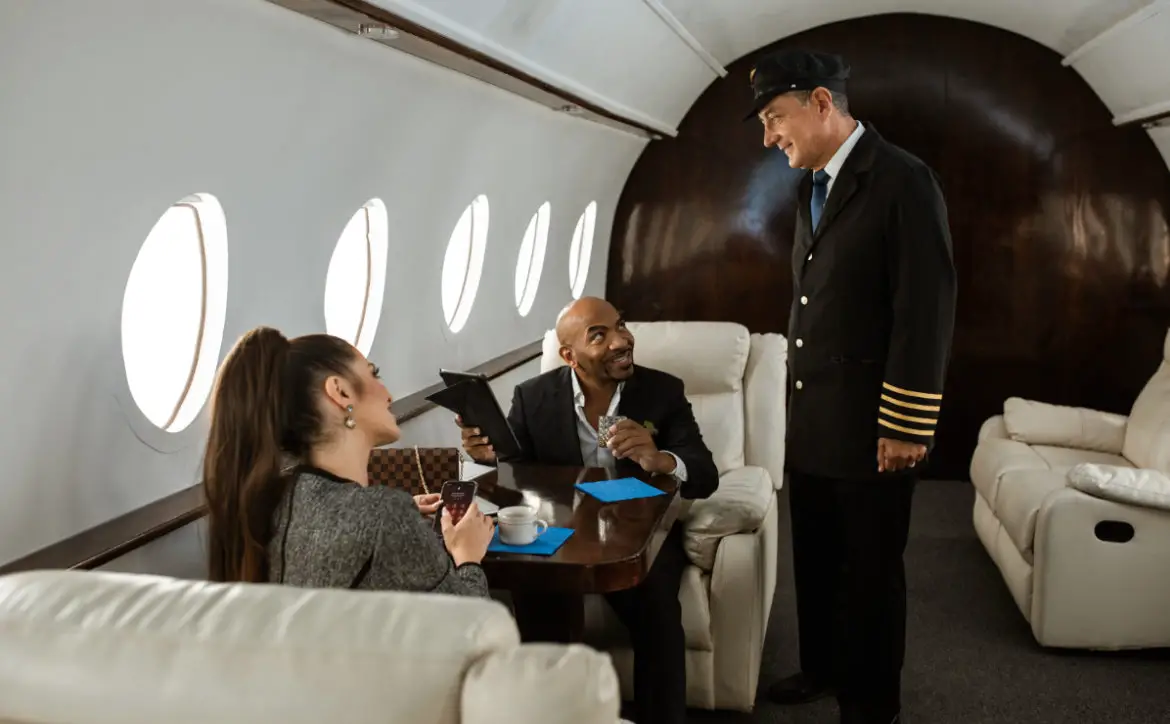Flying in a private jet or plane is a luxurious experience further enhanced by new and novel technology. Some of these aircraft come equipped with features that make the ride safer for passengers and more enjoyable.
Estimated reading time: 5 minutes
With that in mind, here are some examples of modern tech on today’s private jets.
1. Robotics
Nearly half of the world’s airlines seek a partner to investigate the potential of robotics further. They seek to use robotic technology to assist with a variety of tasks. This can include passenger management, baggage handling, and even car parking. It can also help free up flight attendants to deal with immediate concerns.
Private airlines in London have already started using this technology. They utilize bots that can communicate with passengers in multiple languages. These robots can even provide real-time flight information.
2. Virtually Reality
Virtual reality is a computer-generated simulation of a three-dimensional image or environment. You can interact with it using special electronic equipment, such as a helmet with a screen. Virtual reality headsets can be used to give passengers an immersive entertainment experience, and pilots will sometimes use them in aviation training to simulate real-world scenarios.
Virtual reality can additionally help those afraid to fly. Through the process of exposure therapy, VR can simulate a flight experience and allow people to confront their fears directly.
3. Internet of Things
The Internet of Things (IoT) refers to an advanced network of interconnected devices. These devices communicate with one another, usually combined with an automated system to gather data and help complete a task.
Within the airline industry, it can allow every element of the plane to be connected to a network. This can help provide real-time data on performance and maintenance, ultimately improving the plane’s efficiency.
4. Cabin Pressure Sensors
Flights at high altitudes can lower air pressure. This pressurization can lead to a 5 to 20% reduction of oxygen in the blood, which can cause passengers to experience health issues, such as headaches.
Sensors can consistently monitor the air pressure to ensure critical systems, such as the outflow valve, are working correctly.
5. Windowless Planes
Some airlines have designed private jets without windows. Instead, the walls are lined with screens projecting a real-time view of the outside. To capture the view, cameras mounted on the plane’s wings collect video footage.
Also, the screens can be split so passengers can see multiple views at one time. This allows for a more interactive and immersive experience. Windowless planes can reduce manufacturing costs and provide greater design flexibility. Without the windows, the aircraft is lighter and can fly quicker.
6. Automatic Data Surveillance Broadcasting (ADBS)
ADSB is a technology that tracks an aircraft through satellite signals. It transmits essential information such as location and altitude without manual input. This gives pilots a chance to see what the controllers see.
Also, the cockpit displays can locate hazardous weather or terrain. This can give pilots information about temporary flight restrictions. ADSB can also help reduce the risk of collisions and provide pilots greater visibility.

7. Climate and Lighting Control
Many private planes allow you to adjust the temperature, which is incredibly convenient for longer flights. Some have also added LED lights throughout the cabin. The crew can change these to mimic the various stages of sunlight.
If you have an early flight, they can lower the brightness to imitate the warm glow of the sunrise. This can help your body recognize the time of day and wake up naturally. Also, these lights are more energy-efficient. In fact, LED bulbs use 75% less energy than incandescent ones.
8. Autopilot
This system allows a pilot to fly the plane without continuous hands-on control. The technology can maintain the course of the aircraft, altitude, and throttle inputs. It may even compensate for any turbulence, allowing passengers to experience a smoother ride. It also keeps them safe by using a computerized system.
A captain flies around 75 hours a month, so the system can reduce their fatigue by keeping the plane on track for the whole journey.
9. On-Board Wi-Fi
Wi-fi can make your flight more convenient. It allows you to catch up on work or enjoy a movie. Wi-fi also helps remote workers stay connected to their team. Many private jets have onboard systems, so you don’t need to share with anyone. It is provided through a land-based or satellite antenna, so the available bandwidth depends on the technique used and the flight’s route.
10. Noise-Canceling Headphones
These headphones can offer higher sound quality. Earphones are essential for long flights when you want to drown out any outside noise. Also, if traveling with a family, these can allow you to get some rest while the kids are still awake. When picking headphones for the flight, consider how much noise you want to block and your budget.
11. Wearable Technology
Wearable tech can help improve routine procedures. For example, Google Glass can let pilots review flight information hands-free. This allows for a more efficient takeoff and landing process.
Some airlines have also created apps for Apple watches so passengers can virtually store boarding passes and receive real-time updates. However, you may need to periodically update your timepiece when newer versions come out.
How Technology Is Enhancing Private Jets
The airline industry can use modern technology to make private planes more efficient. The devices can also improve your flight experience. As technology continues to advance, the flight industry will continue to evolve.
How would you like to fly on a private jet? Please share your thoughts on any of the social media pages listed below. You can also comment on our MeWe page by joining the MeWe social network.











